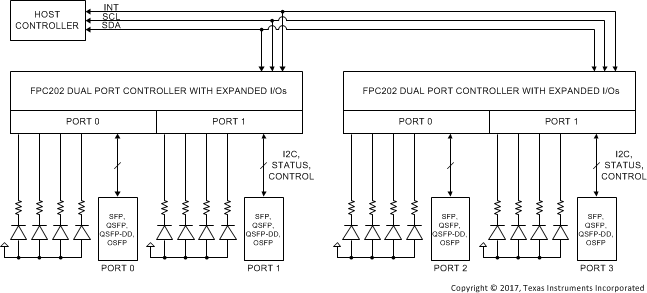SNLS564B December 2017 – January 2024 FPC202
PRODUCTION DATA
- 1
- 1 Features
- 2 Applications
- 3 Description
- 4 Device Comparison Table
- 5 Pin Configuration and Functions
- 6 Specifications
-
7 Detailed Description
- 7.1 Overview
- 7.2 Functional Block Diagram
- 7.3
Feature Description
- 7.3.1 Host-Side Control Interface
- 7.3.2 LED Control
- 7.3.3 Low-Speed Output Signal Control
- 7.3.4 Low-Speed Input Status and Interrupt Generation
- 7.3.5 Downstream (Port-Side) I2C Master
- 7.3.6 Data Pre-Fetch From Modules
- 7.3.7 Scheduled Write
- 7.3.8 Protocol Timeouts
- 7.3.9 General-Purpose Inputs/Outputs
- 7.3.10 Hot-Plug Support
- 7.4 Device Functional Modes
- 7.5 Programming
- 8 Application and Implementation
- 9 Device and Documentation Support
- 10Revision History
- 11Mechanical, Packaging, and Orderable Information
Package Options
Refer to the PDF data sheet for device specific package drawings
Mechanical Data (Package|Pins)
- RHU|56
Thermal pad, mechanical data (Package|Pins)
Orderable Information
3 Description
The FPC202 dual port controller serves as a low-speed signal aggregator for common port types such as SFP, QSFP, Mini-SAS HD, and others. The FPC202 aggregates all low-speed control and I2C signals across two ports and presents a single easy-to-use management interface to the host (I2C or SPI). Multiple FPC202s can be used in high-port-count applications with one common control interface to the host.
The FPC202 is designed to allow placement on the bottom side of the PCB, underneath the press fit connector, to simplify routing. This localized control of the ports’ low-speed signals cuts system bill of materials (BOM) cost by enabling the use of smaller I/O count control devices (FPGAs, CPLDs, MCUs) and by reducing routing layer congestion.
The FPC202 is compatible with standard SFF-8431, SFF-8436, and SFF-8449 low-speed management interfaces, including a dedicated 100/400-kHz I2C interface to each port. Additional general-purpose pins are available to perform functions such as driving port status LEDs or controlling power switches. The LED drivers have convenience features such as programmable blinking and dimming. The interface to the host controller can operate on a separate supply voltage between 1.8 V and 3.3 V to support low-voltage I/Os.
For each port, the FPC202 has a total of four LED drivers, 12 general-purpose I/Os, and two downstream I2C busses. This expanded set of I/Os allows for control of additional components and features within a system. The general-purpose outputs can be used to drive additional LEDs if more than four are required per port.
The FPC202 can pre-fetch data from user-specified registers in each module, making the data readily accessible to the host through a fast I2C (up to 1 MHz) or SPI (up to 10 MHz) interface. In addition, the FPC202 can trigger an interrupt to the host whenever critical, user-configurable events occur associated with any of the ports under its control. This eliminates the need to continuously poll the modules.
 Simplified Block Diagram
Simplified Block Diagram